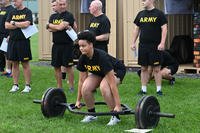The primary way to improve times for military timed runs is to practice purposeful running. This means running at a set pace, distance and time to prepare yourself for the running required in an upcoming fitness test or training program.
However, there are other ways to maintain and even improve your running skills without actually running. Sometimes runners need to take a break due to an injury, busy schedule or their deployment situation.
Here are several ways to improve running by other means:
Flexibility, Mobility, Massage
Add flexibility and mobility elements to your workout, along with active massage for soft-tissue tightness, aches and pains. In our workouts, we either do them all in a single session we call Mobility Day or perform a small portion of the Mobility Day exercises after each training day. These activities can improve speed, running efficiency and stride mechanics.
Flexibility training requires stretching the muscles around a joint. Think of static stretching -- a passive method of holding a stretch at the end range of a muscle’s length -- as flexibility.
Mobility training is working the joint through a full range of motion. Dynamic stretching is a method to increase joint and muscle mobility.
Both are helpful to the runner and the tactical athlete as well. When the muscle gets tight or knotted, self-massage can address common sore muscles. Tools like foam rollers, tennis balls, lacrosse balls and some vibrating tools can relieve the stiffness not relieved by stretching or dynamic stretching.
Our Mobility Day is a training session devoted to non-impact cardio (running rest), flexibility, mobility and massage. We do one in the middle of the week and at the end of the week (Day 3 or 4 and Day 7).
Mobility Day (walk-through video)
Repeat 5 times
Non-impact cardio option: 5 minutes
Stretch, foam roll, massage: 5 minutes
OR
Daily Mini-Mobility Day Session (post workout)
Depending on your needs, you can do this 1-2 times:
Non-impact cardio option: 5 minutes
Stretch, foam roll, massage: 5 minutes
Wide Variety of Non-impact Cardio Options
Many need a break from running at some point in the year. Consider adding any of the following as a substitute: biking, rowing, elliptical machine, stair stepper, cross country skiing or swimming.
If you push yourself on these non-impact options, all of these exercises can improve your running. This means adding sprints at fast and slow intervals, Tabata intervals (20-second sprint, 10 seconds easy) and steady pace for time. You also will need resistance training, using pyramids (each minute increases the resistance and elevation).
If you have multiple options available, consider building your own non-impact cardio triathlon for workouts: bike, row and swim for 20 minutes each with different levels of intensity. This is a great way to challenge your endurance training without the pain of impact.
Strength Training
When you cannot run or decide to take some time off from running, calisthenics or weighted movements can help you build a stronger running base. They will make your leg and hip muscles stronger and more durable and help handle the impact of the next run cycle.
Exercises like lunges will develop the muscles that produce a more powerful and efficient stride. A more explosive option is to mix in jumping lunges on leg day. These can enhance shorter distance speed as well as overall running mechanics.
When running, you will be working the lungs and the legs. Though you will not need to be squatting or deadlifting two times your body weight, adding some strength is a necessity for the tactical athlete, since there is more to the job than timed runs on PT tests.
If new to strength training, consider adding lunges and jumping lunges (squats and jumping squats) to develop strength and power. This will help you run better when you start running again.
Actively Pursue Recovery
Regardless whether you are in a running cycle or taking a break from running, there should be days each week where you focus on your recovery and health. This means eating well, sleeping well, reducing stress and resting. When you are not training, you should have the mindset that you are working to recover from the previous training session as well as preparing for the next training session. You will not get faster or stronger or heal from injury without rest and recovery.
After a running injury, coming back faster and healthier can be achieved by focusing on injury recovery through tough non-impact training, good sleep, rest days, healthy nutrition and a mix of flexibility, mobility and massage. You may find that you enjoy a six- to eight-week cycle of non-impact and recovery training mixed into your training year, regardless of whether you’re injured or not.
The enemy to training is the same old routine week after week. By mixing it up, you will be a healthier athlete overall and not have to sweat getting slower at running when not focused on running.
Stew Smith is a former Navy SEAL and fitness author certified as a Strength and Conditioning Specialist (CSCS) with the National Strength and Conditioning Association. Visit his Fitness eBook store if you’re looking to start a workout program to create a healthy lifestyle. Send your fitness questions to stew@stewsmith.com.
Want to Learn More About Military Life?
Whether you're thinking of joining the military, looking for fitness and basic training tips, or keeping up with military life and benefits, Military.com has you covered. Subscribe to Military.com to have military news, updates and resources delivered directly to your inbox.


















